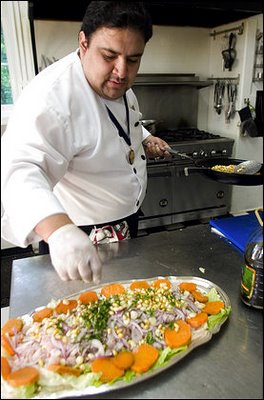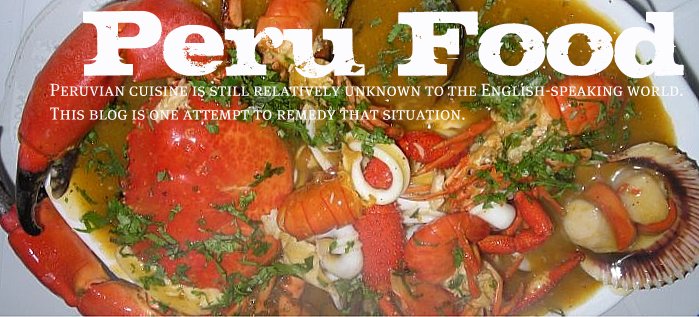He understands the fusion element in Peruvian cooking. "Take one part Incan and one part Spanish. Mix well. Add influences of African, Chinese, Japanese and Italian. What do you get?" he asks.
Of course, we know the answer.
He writes: "The staples of Peruvian cuisine -- potatoes, yucca, corn and chili peppers -- were provided by the Incas centuries ago. Spanish conquistadors who arrived in the 16th century brought citrus fruit, wheat, rice, cattle and pigs as well as European-style desserts. Africans introduced spicy, vinegar-marinated beef and fish on skewers.
Then came the Chinese, who came to build railroads. They introduced soy sauce and fresh ginger as well as stir-fry cooking. Japanese arriving in the early 1900s to work on sugar and cotton plantations brought their love of seafood and techniques for preparing it simply and beautifully."
Although he means Andeans instead of Incas (the Inca Empire only lasted about 150 years, but many pre-Inca cultures had existed in the Andes for millenia), he gets it.
Nicholls reminds us that "legendary French chef and culinary writer Auguste Escoffier" listed Peruvian cuisine as one of the best in the world. Despite this fame, Nicholls laments, "Considering its status, (Peruvian cusine) ... been relatively overlooked."
In this article, Nicholls interviews Alejandro Riveros, head of public diplomacy for the Embassy of Peru in Washington D.C. During their conversation, Riveros acknowledges he, "has made it his mission to promote the sophistication, innovation and most importantly, taste, of foods from back home."
Most recently among Riveros' triumphs was a thousand-person food sampling at the Peruvian Embassy in celebration of the signing of the free trade agreement between Peru and the United States.
Nicholls quotes Riveros: "We want our food to be as well known as Thai is in this country. We want 5,000 -- no 10,000 -- restaurants in the United States. We want Peruvian restaurants everywhere."
Riveros is spearheading a marriage between investors and chefs, the two linchpins to promoting Peruvian cuisine, with an eye to opening a high-end Peruvian restaurant in downtown Washington D.C
For Washingtonians, Peruvian cuisine means the ubiquitous pollo a la brasa rotisserie chicken, such as El Pollo Rico, opened in 1989 in Arlington, and now so popular, long lines form during the lunch and dinner rushes. Other Washington-area favorites include Crisp & Juicy, Señor Chicken and The Inkas' Empire.
The fare presented by the Peruvian Embassy is quite different from what is served in these family-style restaurants.
At a recent dinner party for 70 at the ambassadorial residence, there were a dozen main courses competing at the buffet table. Excutive chef Jose Luís Herrerra prepared, "a creamy, purple, Italian-style olive sauce over thinly sliced octopus;" "Andean corn for a Japanese-inspired, citrus-marinated fish dish, ceviche"; and, "a Chinese stir-fry of beef tenderloin and red onions seasoned with soy sauce and tossed with french fries". Causa, the famouse "layered torte made with cool mashed potato, filled with tuna salad, (and) festively coated with a colored mayonnaise sauce" also made an appearance. As did, "a Spanish, port wine-flavored custard topped with meringue and a touch of cinnamon" for dessert.

The Peruvian Embassy barman, Marcelino Lázaro (who has been shaking pisco sours at Embassy receptions and cocktail parties for the last 20 years) explained that the perfect pisco sour, depends on "the proportions." Nicholls concludes that the pisco sour, "like much of Peruvian cooking, packs a punch."
To read the complete article from the Washington Post, click here. (Registration may be required.)
Peru.Food@gmail.com
.
.
.
Click here for the Peru Food main page.
TAGS: Peru, Peruvian, food, cooking, cuisine, cocina, comida, gastronomía, peruana
TAGS: Peru, Peruvian, food, cooking, cuisine, cocina, comida, gastronomía, peruana

3 comments:
Bienvenido de nuevo a la blogosfera, Gato Volador, extrañábamos tus comentarios tan actualizados y tan oportunos.
Saludos
Maria Elena
Gracias Maria Elena.
vegetable side dish, I know. The next time I go to Peru I have a long list of things to photograph.
Thanks for stopping by.
Gato
.
.
.
Post a Comment